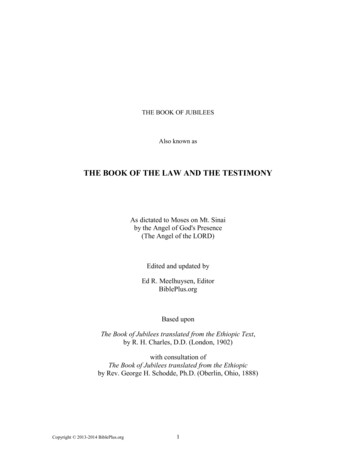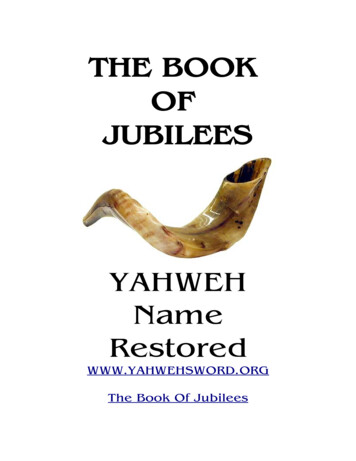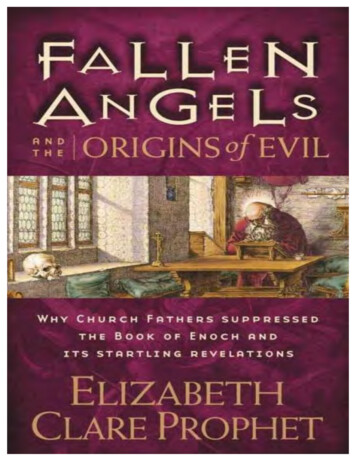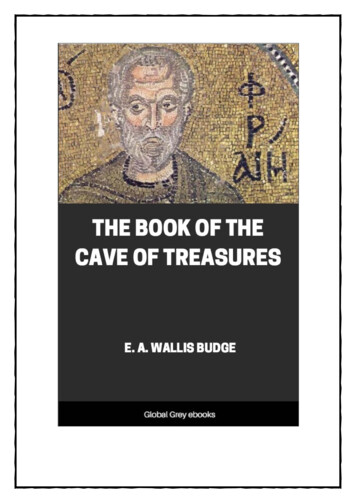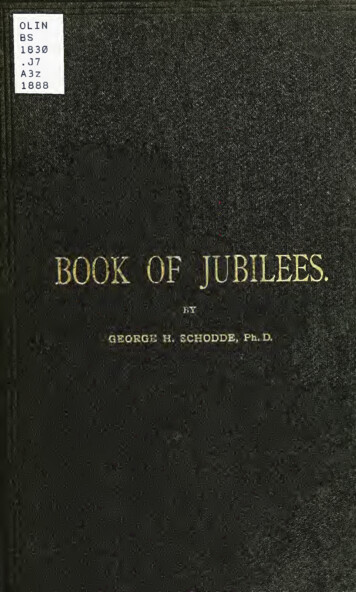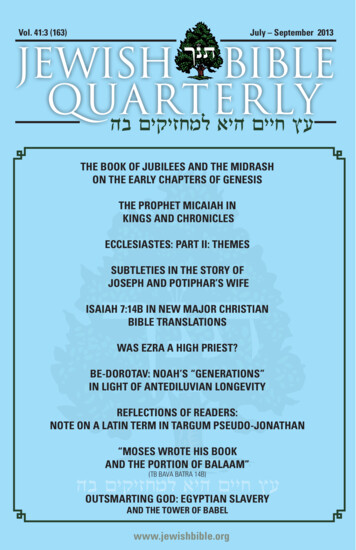
Transcription
Vol. 41:3 (163)July – September 2013THE BOOK OF JUBILEES AND THE MIDRASHON THE EARLY CHAPTERS OF GENESISTHE PROPHET MICAIAH INKINGS AND CHRONICLESECCLESIASTES: PART II: THEMESSUBTLETIES IN THE STORY OFJOSEPH AND POTIPHAR’S WIFEISAIAH 7:14B IN NEW MAJOR CHRISTIANBIBLE TRANSLATIONSWAS EZRA A HIGH PRIEST?BE-DOROTAV: NOAH’S “GENERATIONS”IN LIGHT OF ANTEDILUVIAN LONGEVITYREFLECTIONS OF READERS:NOTE ON A LATIN TERM IN TARGUM PSEUDO-JONATHAN“MOSES WROTE HIS BOOKAND THE PORTION OF BALAAM”(TB BAVA BATRA 14B)OUTSMARTING GOD: EGYPTIAN SLAVERYAND THE TOWER OF BABELwww.jewishbible.org
THE JEWISH BIBLE QUARTERLYIn cooperation withTHE DEPARTMENT OF EDUCATION, THE JEWISH AGENCYAIMS AND SCOPEThe Jewish Bible Quarterly provides timely, authoritative studies on biblical themes.As the only Jewish-sponsored English-language journal devoted exclusively to the Bible, itis an essential source of information for anyone working in Bible studies. The Journal publishes original articles, book reviews, a triennial calendar of Bible reading and correspondence. Publishers and authors: if you would like to propose a book for review, please sendtwo review copies to BOOK REVIEW EDITOR, POB 29002, Jerusalem, Israel. Bookswill be reviewed at the discretion of the editorial staff. Review copies will not be returned.The Jewish Bible Quarterly (ISSN 0792-3910) is published in January, April, July andOctober by the Jewish Bible Association, POB 29002, Jerusalem, Israel, a registered Israeli nonprofit association (#58-019-398-5). All subscriptions prepaid for complete volumeyear only. The subscription price for 2013 (volume 41) is 24. Our email address: info@jewishbible.org and our website: www.jewishbible.org. Single articles can be orderedthrough www.bl.uk All submissions to the JBQ (including Letters) must be submitted electronically by email. Telephone: 972-2-6216145.Founded by. LOUIS KATZOFF, Editor 1972 – 1987 as DOR LE-DORPAST ASSOCIATE EDITORS:CHAIM ABRAMOWITZ, DAVID WOLFERS, CHAIM PEARL,THEODORE STEINBERG, PATRICIA BERLYNEditor: ZVI RONEditor Emeritus: SHIMON BAKONAssociate Editors: DAN VOGEL, RUTH WALFISHManaging Editor: JOSHUA J. ADLEREditorial Secretary: JOSH BACKONJEWISH BIBLE ASSOCIATIONChairman: GABRIEL SIVANMEMBERS OF THE BOARDJONATHAN BEN-ARI (KATZOFF)GAD DISHIGILAD GEVARYAHUYOSEF GREENALAN GREENSPANHAYYIM HALPERNREUVEN HAMMERRICHARD HIRSCHPINCHAS KAHNNANCY ORDWAYCOVER DESIGN BY BENJIE HERSKOWITZGARRI REGEVPESACH SCHINDLERHAIM SKIRBALLSHUBERT SPEROWALTER ZANGER
THE JEWISH BIBLE QUARTERLYVol. 41, No. 3 (163)JULY – SEPTEMBER2013THE BOOK OF JUBILEES AND THE MIDRASH ONTHE EARLY CHAPTERS OF GENESISZvi Ron143THE PROPHET MICAIAH IN KINGS ANDCHRONICLESDavid J. Zucker156ECCLESIASTES: PART II: THEMESAron Pinker163SUBTLETIES IN THE STORY OF JOSEPHAND POTIPHAR'S WIFEShimon Bakon171ISAIAH 7:14B IN NEW MAJOR CHRISTIANBIBLE TRANSLATIONSClifford H. Durousseau175WAS EZRA A HIGH PRIEST?Reuven Chaim Klein181BE-DOROTAV: NOAH'S "GENERATIONS" IN LIGHTOF ANTEDILUVIAN LONGEVITYJeffrey M. Cohen187REFLECTIONS OF READERS: NOTE ON A LATINTERM IN TARGUM PSEUDO-JONATHANEugene Wernick191"MOSES WROTE HIS BOOK AND THE PORTION OFBALAAM" (TB BAVA BATRA 14B)Shubert Spero193OUTSMARTING GOD: EGYPTIAN SLAVERYAND THE TOWER OF BABELSheila Tuller Keiter200ARTICLES IN THE JBQ ARE INDEXED AND ABSTRACTED BY:Internationale Zeitschriftenschau für Bibelwissenschaft und Grenzgebiete,Old Testament Abstracts, Religious and Theological Abstracts,Index of Articles on Jewish Studies (Rambi), Index to Jewish Periodicals,Religion Index One: Periodicals
THE BOOK OF JUBILEESAND THE MIDRASH ON THE EARLY CHAPTERS OFGENESISZVI RONThe Book of Jubilees is a retelling of Genesis and the beginning of Exodusin the form of an angel speaking to Moses. It was written by a Jew in Hebrewsome time around the early second century BCE, perhaps even earlier. Theoriginal Hebrew is lost to us today; our translations are based primarily onEthiopic texts. The main focus of the work is to demonstrate that the narratives in the early part of the Bible contain legal instruction, although the legalelements are hidden in the biblical narrative.1 Jubilees often supplements thebiblical narratives with additional information, in much the same way as theMidrash; at other times Jubilees provides a resolution to a difficulty in thebiblical text, another concern of the Midrash. As such, the Book of Jubileesmay be categorized as an early form of midrashic literature.2 Some of theinterpretations in Jubilees are, in fact, preserved in later midrashic literature.The title "Book of Jubilees" reflects the author's particular way of viewingthe chronology of the world as a series of forty-nine year cycles, but it wasalso sometimes referred to as "The Little Genesis" (Bereshit Zuta in Aramaic),3 since it is an abbreviated retelling of Genesis.4 Jubilees was not incorporated into rabbinic literature, as it differs in some very fundamental legalpoints, most famously its insistence on a purely solar calendar, as opposed tothe rabbinic lunar/solar model,5 and stringencies regarding Shabbat observance.6 In this article we will show how Jubilees dealt with various difficulties in the text of Genesis in ways sometimes similar to and sometimesvery different from the later rabbinic midrashic literature. We will focus onthe first portion of Genesis, from chapter 1 to 6:8, and on aggadic rather thanhalakhic matters.Zvi Ron received semikhah from the Israeli Rabbanut and his Ph.D. in Jewish Theology fromSpertus University. He is an educator living in Neve Daniel, Israel, and the author of Sefer Katanve-Gadol (Rossi Publications: 2006) about the large and small letters in Tanakh. He is the Editorof The Jewish Bible Quarterly.
ZVI RON144DAY AND NIGHT BEFORE THE CREATION OF THE SUN AND MOONThe Bible begins counting days even before the creation of the sun andmoon on the fourth day, leading to the well-known question as to how theterms first, second and third day and night can apply before the sun and mooncame into existence. Jubilees, in recording what God created on the first day,states: He created the abysses and darkness – both evening and night – andlight – both dawn and daylight (Jub. 2:2). Thus, daylight existed before thesun, as did the darkness of night, so that actual 24-hour days could be counted even without the sun.7TB Hagigah 12a offers a few approaches to this question. R. Eliezer explains that "with the light that God created on the first day one could see fromone end of the world to the other," meaning that the Bible in the first threedays refers to a special light having nothing to do with the sun. This light isset aside for the righteous to enjoy in the future. The Sages, however, explainthat in fact the sun and moon were created on the first day and gave light, butthey were fixed in their places only on the fourth day. This is the view followed by Ibn Ezra in his commentary to Genesis 1:5, and by Maimonides inhis Guide for the Perplexed (2:30).8 Alternatively, Genesis Rabbah (3:7)suggests that this indicates that the concept of time (seder zemannim) hadalready come into existence before – a view rejected by Maimonides, sincehe associates it with the theory that the universe always existed.In Jubilees, solar chronology is a central concern, so it makes sense thatdaylight should be created on the first day. The rabbis were less concernedwith the particulars of timekeeping, and could offer an approach that the lightin this passage is not sunlight, or that timekeeping began even before creation, ideas that are anathema to Jubilees.ADAM BEFORE ENTERING EDENGenesis 2:8 and 2:15 both state that God placed Adam in the Garden ofEden. The Lord God planted a Garden in Eden, to the east, and placed therethe man whom He had formed (Gen. 2:8) implies that Adam was brought toEden from somewhere else. After a short geographical account of its location, the narrative recaps, The Lord God took the man and placed him in theGarden of Eden, to work it and to guard it (Gen. 2:15). This further indicatesJEWISH BIBLE QUARTERLY
THE BOOK OF JUBILEES145that Adam was taken from somewhere and brought to Eden. Why wasn't Adam simply created in Eden in the first place? In Jubilees the angel explains:And after forty days were completed for Adam in the land where he was created, we brought him into the Garden of Eden so that he might work it andguard it (Jub. 3:9). The forty-day period is explained in Jubilees as prefiguring the biblical laws of impurity after a woman gives birth to a boy, when shemay not touch anything sacred and she may not enter the Sanctuary (Lev.12:4). Jubilees reports that Eve was only brought into the Garden after eightydays, because it is more holy than any land (Jub. 3:12). This period of purification mirrors that of a woman after giving birth to a girl (Lev. 12:5). BothAdam and Eve had to undergo a period of purification before entering theGarden of Eden.Rabbinic tradition also understands that Adam was not created in Eden, asthe verse clearly states that he was brought there from somewhere else. Genesis Rabbah (14:8) teaches that Adam was created from the earth at MountMoriah. Pirkei de-Rabbi Eliezer states that the entrance to the Garden ofEden was right next to Mount Moriah. There is no mention of the need for aforty-day purification period. In fact, Pirkei de-Rabbi Eliezer explicitlypoints out that Adam was created using earth from a holy and pure place.9Hizkuni explains that the reason for Adam being created outside the Garden –so that he could appreciate how wonderful Eden was after seeing the thornsand thistles of the outside world. This seems to contradict Genesis 3:18,Thorns and thistles shall it sprout [tatzmi'ah] for you, implying that beforeAdam sinned, thorns did not grow from the ground. However, Hizkuni understands the word tatzmi′ah in that verse to mean you will plant, indicatingthat man will now have to plant thorns and thistles around his gardens to protect the produce from animals which, after Adam's sin, no longer fear man.Another approach found in Genesis Rabbah (15:4) is that the term vayasem ("He put," Gen. 3:8) does not refer to physical placement, but rather toan appointment, as in You shall surely set over (tasim) yourself a king (Deut.17:15). According to this view, the verse is telling us that God appointed Adam as ruler of the Garden of Eden, but that he was there all along.Rabbinic tradition generally disregards the approach of Jubilees, based onthe idea in TB Shabbat 135a that the concept of forty days of impurity following childbirth only came into existence after the Torah was given. HowVol. 41, No. 3, 2013
146ZVI RONever, Midrash Tadshe, also known as the Baraita of Pinhas ben Ya′ir, doesstate that the forty days of impurity after childbirth correspond to the fortydays Adam waited before entering the Garden of Eden.10 Midrash Tadshe,written in the early eleventh century and based on earlier material, is one ofthe few rabbinic works that incorporate material from Jubilees, although it isby no means viewed as a canonical midrash.11TIME IN THE GARDEN OF EDEN BEFORE THE SINThe Bible does not indicate how long Adam and Eve lived in the Garden ofEden before they sinned and were expelled. According to Jubilees 3:15, Adam and his wife had been in the Garden of Eden for seven years tilling andguarding it, then At the end of seven years which he completed there, sevenyears exactly, in the second month on the seventeenth day, the serpent cameand drew near to the woman (Jub. 3:17). The idea that Adam and Eve livedblissfully for seven years fits into the general view of Jubilees that historyworks in units of forty-nine year jubilee periods which are subdivided into"weeks," i.e., seven- year periods.12Rabbinic tradition considerably shortens the length of time that Adam livedin the Garden of Eden. TB Sanhedrin 38b states that Adam and Eve sinned inthe tenth hour of the first day, were judged in the eleventh, and exiled in thetwelfth hour. Genesis Rabbah (18:6) shortens the time still further and explains that the blissful time did not even last for six hours. These approachesview Adam's stay as an extremely brief period of time, expressed as eitherone day (the rabbinic period of daylight being 12 hours) or half a day.R. David Tzvi Hoffmann (1843-1921) explains that the rabbis felt that ashorter amount of time makes sense, because it is unreasonable to assumethat man would be left for as long as seven years with only one commandment to perform, and a negative one at that.13ANIMALS SPEAKINGThe Bible records that the serpent spoke to Eve, yet we are not explicitlytold when it was deprived of this power of speech. Jubilees (3:28) explainsthat on the day Adam and Eve were expelled from the Garden of Eden, themouth of all the beasts and cattle and birds and whatever walked or movedwas stopped from speaking because all of them used to speak with one anothJEWISH BIBLE QUARTERLY
THE BOOK OF JUBILEES147er with one speech and one language. Prior to Adam’s sin, the serpent and allother creatures were able to speak, but afterwards they lost this ability.There are many different approaches to the question of the serpent's speechin rabbinic literature. It is not even clear if, at the time, all snakes could speakor only this one.14 Saadiah Gaon explains that an angel spoke through theserpent, which is similar to his understanding of the episode of Balaam's ass,where the animal was not given intelligence but an angel spoke and the assonly appeared to be talking. Ibn Ezra records the approaches according towhich Eve understood the language of snakes, or the snake communicatedusing signs which Eve interpreted, or else the serpent was actually Satan inthe form of a snake. Ibn Ezra himself declares that it seems reasonable to himthat the serpent actually spoke and was an intelligent creature that used towalk upright.15 This approach is also found in the early commentary MidrashLekah Tov, which further states that the serpent was speaking Hebrew.16Radak strongly disagrees, opining that if the serpent was intelligent and couldactually speak, the removal of these attributes would surely have been mentioned in the curse God placed on him, a deprivation far more significant thanlosing the ability to walk upright. Furthermore, if the snake was intelligent,he should have been singled out in the biblical account of the creation ofbeasts. Radak concludes, like Saadiah, that the serpent's speech was a miraculous occurrence.17 However, there are rabbinic sources, such as Avot deRabbi Natan (chapter 42), where the inability to speak is in fact listed as oneof the curses imposed on the serpent. Rabbenu Bahya (Gen. 3:14) explainsthat an inability to speak is a curse so severe and obvious that it did not haveto be stated explicitly in the Bible.Whichever way the speech of the serpent is understood, there are no rabbinic sources which claim that before Adam's sin all animals could speak.18However, this idea is found in other early non-rabbinic Jewish sources suchas Josephus19 and Philo,20 indicating that it was a common belief at one time,rejected by the rabbis. From the rabbinic perspective, the fact that the serpentspoke was unique and remarkable; it was also hard to explain, because thepower of speech could not be seen as shared by the rest of the animal kingdom. The basic reason for the rabbinic rejection of animal speech seems to bethat it would blur the distinction between man and animals, speech beingregarded as a uniquely human ability.21Vol. 41, No. 3, 2013
ZVI RON148WIVES OF CAIN AND ABELThe Bible does not record who Cain and Abel married, nor does it indicatewhether any women were available as marriage partners. However, the Bookof Jubilees (4:1, 4:9) explains that Eve had a daughter, Awan whom Caintook as a wife. Similarly, Seth took a sister, Azura, as his wife (Jub. 4:11) andhis son, Enos, married his sister Noam (Jub. 4:13). This trend continued withhis son Kenan, who married his sister Mu'aleleth (Jub. 4:14). The first recorded union of an offspring of Adam with someone other than a sister is thatof Kenan's son, Mahalalel, who married Dinah, his cousin's daughter (Jub.4:15). From this point onward there were no further marriages with sisters.Rabbinic tradition states that sisters were born with Cain and Abel. According to TB Yevamot 62a, each boy was born with a twin sister, whereas Genesis Rabbah (22:3) relates that Cain had a twin sister and that Abel was a triplet, two sisters having been born with him. According to TB Sanhedrin 58band many other rabbinic sources, Cain and Abel married their sisters.22 Genesis Rabbah (22:7) explains that a fight between Cain and Abel over the third("extra") sister led to Abel's murder.In this case Jubilees and rabbinic tradition agree that Cain married his sister, as no other option was available. However, Jubilees continues this trendfor further generations, something not found in rabbinic tradition. Such unions were understood to be limited to the children of Adam, when there wasno alternative. In Jubilees this form of marriage lasts until the time of theNephilim.23 It is not unusual for the birth of daughters to go unmentioned inthe Bible, and for wives not to be named. For the most part, biblical genealogical lists include only males. It is also not unusual for Jubilees to name thewives of these biblical personalities; one characteristic of Jubilees being thelarge number of proper names it supplies, particularly of women.24DEATH AFTER EATING FROM THE TREE OF KNOWLEDGEGod warns Adam not to eat from the Tree of Knowledge, for on the dayyou eat of it, you shall surely die (Gen. 2:17). The fact that Adam and Eve donot die instantaneously upon eating the forbidden fruit led to various interpretations of the death penalty mentioned by God. Jubilees explains that Adamdied at the age of 930, and he lacked seventy years from one thousand years,for a thousand years are like one day in the testimony of heaven and thereJEWISH BIBLE QUARTERLY
THE BOOK OF JUBILEES149fore it was written concerning the Tree of Knowledge, 'In the day you eatfrom it you will die.' Therefore he did not complete the years of this day because he died in it (Jub. 4:30).The idea that a day is a thousand years from the perspective of God is rooted in Psalm 90:4: A thousand years in Your sight are like yesterday. That thepunishment of death meant that Adam would not live a full thousand-year"day" is also found in Genesis Rabbah (19:8).However, another opinion in Genesis Rabbah (16:6) offers the approachthat now, for the first time, man became mortal. Rabbenu Bahya adds theview of "scientists" that until Adam sinned man would only die a naturaldeath; thereafter, as a result, the concept of an untimely death came into being.25 Other rabbinic approaches include the view expressed in ToledotYitzhak, that the punishment was indeed supposed to be instantaneous death,which was, however, averted when Adam repented.26In this instance, the view of Jubilees did not contain anything unreasonableas far as the Sages were concerned. It dovetailed with the biblical statementsthat Adam lived to 930 and that a day can considered as lasting a thousandyears. The same explanation may thus be found in Jubilees and in rabbinicliterature.DEATH OF CAINThe Bible does not tell us how Cain died, but Jubilees records: His housefell upon him, and he died in the midst of his house. And he was killed by itsstones because he killed Abel with a stone, and with a stone he was killed byrighteous judgment. Therefore it is ordained in the heavenly tablets,27 'Withthe weapons with which a man kills his fellow he shall be killed, just as hewounded him, thus shall they do to him' (Jub. 4:31-32).This is at variance with rabbinic teachings. TJ Sanhedrin 7:3 specificallyasks, "Can it be that if the murder was committed by sword, he is punishedby sword and if with a rod, he is punished by a rod?", and then proceeds toreject this view. TB Sanhedrin 52b also states that all murderers are punishedby the sword. There is no concept that the murderer should be put to death inthe same way he committed his crime.28 However, the idea that Cain killedAbel with a stone is found in the Midrash. Genesis Rabbah (22:8) records adispute between R. Shim'on ben Gamliel and the Sages as to the type ofVol. 41, No. 3, 2013
150ZVI RONweapon Cain used against his brother; the former says it was a reed, the lattersay it was a stone.29 Still, the rabbis do not have the tradition that Cain waskilled with a stone, i.e., measure for measure, or that murderers in generalshould be punished in this way. According to rabbinic tradition, Cain wasaccidentally killed by his descendant Lemech while hunting with a bow andarrow.30While the Bible does speak of measure-for-measure punishment, a life for alife, an eye for an eye, a tooth for a tooth (Ex. 21:23-25), this was neverunderstood to extend to the manner of dispensing justice, to punish in thesame exact way that the offense was committed. For this reason, the approachof Jubilees – that we learn this principle from Cain's death – is untenable inrabbinic thinking. However, the idea that Cain used a stone to kill Abel doesnot pose any halakhic problems and may seem reasonable, since they werefighting in the field (Gen. 4:8),31 and so it could be adopted by the rabbis aswell.THE DISAPPEARANCE OF ENOCHThe Bible tells us very little about Enoch, and what we are told is mysterious. Enoch walked with God, then he was no more, for God had taken him(Gen. 5:24). Why did God take him, and where? Jubilees has a long sectionon Enoch (Jub. 4:16-26). There it is explained that he was the first man wholearned writing and knowledge and wisdom and who wrote in a book thesigns of the heaven according to the order of their months (Jub. 4:17), so thatpeople could observe holidays in their proper time. He recorded history (Jub.4:18) and had visions of the future (Jub. 4:19). The angels took him for sixjubilees of years, and they showed him everything which is on earth and inthe heavens, the dominion of the sun (Jub. 4:21), which he recorded in writing (Jub. 4:22). He was taken by angels to live in the Garden of Eden forgreatness and honor, and behold he is there writing condemnation and judgment of the world, all of the evils of the children of men (Jub. 4:23). According to Jubilees, Enoch is a very significant figure, particularly since Jubileesis very concerned with the solar calendar and chronology. Enoch is the onewho received this knowledge from the angels and taught it to man. He continues to record history as an eternal watcher, privileged to live in Eden.JEWISH BIBLE QUARTERLY
THE BOOK OF JUBILEES151The idea of Enoch as an Elijah-like figure, who never actually died andnow functions as a heavenly scribe, is found in many Apocryphal works andin ancient non-rabbinic writings such as Philo and Josephus.32 Rabbinic literature tends to take a different view. In Genesis Rabbah (25:1) Enoch is described as a person who was sometimes righteous and sometimes not, so Goddecided to end his life while he was still in a state of righteousness. We findin the same midrash a few instances where sectarians (Judeo-Christians) andGentiles claim that Enoch never died and became an immortal being, only tobe refuted by rabbis who insist that Enoch did die. From this passage we canunderstand rabbinic opposition to the notion of Enoch becoming a supernatural entity and even being especially righteous. The idea of a person becoming an angel was considered dangerous, particularly in the context of debateswith early Christians, and any verse that could be interpreted in a way thatavoided this concept was given some different explanation.33Even so, the idea that Enoch lived in Eden and learned astronomy from theangels did find its way into the Midrash Aggadah, where Enoch is understood to have been transformed into the angel Metatron.34 Both views ofEnoch seem to be represented in rabbinic literature.35 There are even twoversions of the translation of this verse by Onkelos. One version translates itas and he was not, for the Lord had killed him, emphasizing that Enoch wasnot immortal and implying that he was not very righteous. The other version,and he still is, for he did not die, is the one accepted by Hizkuni and RabbenuBahya. Despite opposition in Genesis Rabbah, this idea managed to survive.THE "SONS OF GOD"One of the most cryptic passages in the Bible is the episode where the sonsof God [benei ha-elohim] saw that the daughters of men were good, and theytook themselves wives from whoever they chose (Gen. 6:2), thereby angeringGod. The meaning of the term benei ha-elohim, and therefore of this entirepassage, is a matter of great debate. Jubilees views the benei ha-elohim asangels who copulated with human women to create the biblical Nephilim,giants (Jub. 5:1-2, 6-7; see Gen 6:4). This view is also found in the Septuagint, Philo, and Josephus, and can be seen as the older interpretation of thispassage.36Vol. 41, No. 3, 2013
152ZVI RONThis interpretation was criticized in certain midrashim. While the Bibleoften refers to angels as benei ha-elohim (e.g., Job 1:6, 2:1; Dan. 3:25), inGenesis Rabbah (26:8) R. Shim'on bar Yohai states that the correct meaningof benei ha-elohim here is "sons of judges", and curses anyone who explainsthat they are angels. The concept of "fallen angels" and the idea that angelscan and did interbreed with humans is very strange, especially since angelsare God's messengers and are understood not to have an evil inclination, thusbeing incapable of sin. It is no wonder, then, that R. Shim'on vehementlyopposed the idea found in Jubilees.37 Similarly, Onkelos translates benei haelohim as human "sons of rulers" who took whichever woman they pleased.Despite R. Shim'on's curse, the idea that benei ha-elohim means angels isfound in the Talmud and other rabbinic sources, showing that an officiallysuppressed notion may still occasionally pop up again in rabbinic literature.These angels are even identified by name, Uzza and Azael.38 The idea is noted as a possible approach by Rashi (on Gen. 6:2), and it is accepted by Ramban (Gen. 6:4) and others.39 Certain midrashim explain that these angels weresent to earth and instilled with an evil inclination as a test, which theyfailed.40 Clearly, the early angelic interpretation in non-rabbinic literature,such as the Book of Jubilees, managed to survive and find its way into rabbinic thought, despite some serious opposition. Not surprisingly, the insertionof angels into the biblical stories is one of the characteristics of Jubilees: thecreation of angels on the first day (Jub. 2:2), angels bringing Adam into theGarden of Eden and teaching him farming (Jub, 3:9, 12, 15), reporting man'ssins to God (Jub. 4:6), and teaching Enoch (Jub. 4:21) – among many otherexamples.41 The Book of Jubilees itself is said to have been dictated by anangel (Jub. 1:27, 2:1). Little wonder that anything in the biblical narrativewhich could lend itself to an "angelic” interpretation is explained that way inJubilees.120 YEARSAccording to the Bible, God said: 'My spirit shall not contend evermoreconcerning man for he is but flesh, his days shall be a hundred and twentyyears' (Gen. 6:3). This passage in Genesis could not be taken at face value,since after this verse many people live beyond 120 years. In Jubilees, thisJEWISH BIBLE QUARTERLY
THE BOOK OF JUBILEES153statement is understood to apply specifically to the offspring of the fallenangels and human women as part of the plan to eradicate them:And against their children a word went forth from before His Presence so that He might smite them with the sword and remove themfrom under heaven. And He said 'My spirit will not dwell upon manforever, for they are flesh, and their days shall be one hundred andtwenty years.' And He sent His sword among them so that each onemight kill his fellow and they began to kill one another until they allfell on the sword and they were wiped out from the earth (Jub. 5:79).42The standard rabbinic view is that the verse means that humanity has 120years to repent before it is destroyed by God in the Flood.43 Although thisverse is found in the context of the benei ha-elohim narrative, it was not taken to refer specifically to the offspring of the benei ha-elohim. This is part ofthe aforementioned rabbinic approach, which sought to emphasize that thebenei ha-elohim and their offspring were regular humans, and so the versemust refer to mankind, not the children of angels.We have seen that the Book of Jubilees deals with many of the same questions and ambiguities in the biblical text that concerned later rabbinic literature. Some of the interpretations found in Jubilees were accepted, some wererejected and others suppressed. The Book of Jubilees affords us a glimpse ofhow the Bible was interpreted in ancient times, centuries before the midrashicliterature with which we are familiar today came to be written.NOTESAll translations of the Book of Jubilees are from O. S. Wintermute, Jubilees: A New Translationand Introduction, in James H. Charlesworth, ed., The Old Testament Pseudopigrapha, vol. 2(New York: Doubleday, 1985).1. James Kugel, The Bible As It Was (Cambridge, Massachusetts: Harvard University Press,1997) pp. 38-39.2. Wintermute, pp. 39-40.3. S. Herr and S. Shrira, Toledot ha-Sifrut ha-Talmudit (Tel Aviv: Haskalah La-Am, 1937) p.247.4. Wintermute, p. 41.5. See A. Z. Aescoly, Sefer ha-Falashim (Jerusalem: Reuven Mass, 1943) pp. 29, 60; and Michael Stone, "Astronomy in the Apocrypha," Mahanayim, vol. 125 (Tishrei 1971) p. 108 (Hebrew).Vol. 41, No. 3, 2013
154ZVI RON6. See Jubilees 50:8, 12, and Avraham Goldberg, "Rabbinic and Biblical Shabbat Prohibitions,"Sinai, vol. 46 (Tishrei 1959) p.183 (Hebrew).7. See also Yehuda Rosental, "Heresy In the Time of Saadia," Horeb, vol. 9 (Nissan 1946) p. 34,note 107 (Hebrew). There is a view th
Eden. The Lord God planted a Garden in Eden, to the east, and placed there the man whom He had formed (Gen. 2:8) implies that Adam was brought to Eden from somewhere else. After a short geographical account of its loca-tion, the narrative recaps, The Lord God took the man and placed him in the Garden
